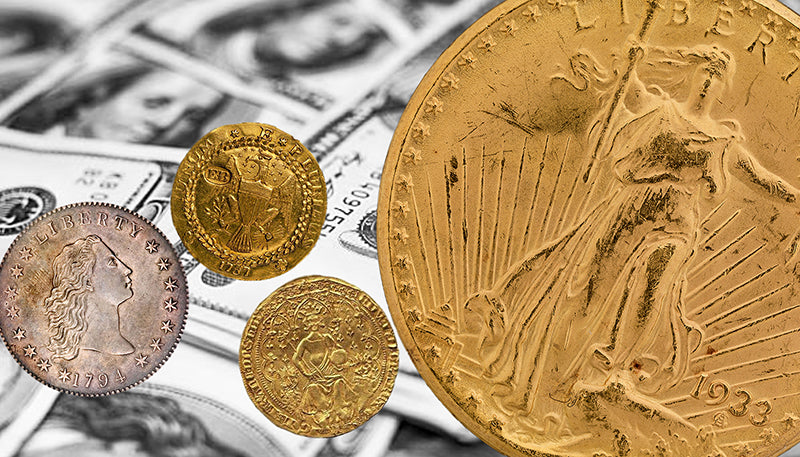What are the Most Expensive Coins in the World?
The funny thing about currency is that, as a material entity, it’s relatively worthless. The paper, and even most metal alloys that today's global currencies are crafted is worth so much less than what we trade it for. In other words, determining what are the most expensive coins in the world has much to do with market value. Yet, it has almost nothing to do with the intrinsic value.
Take the American dollar, for example. This famed currency is arguably the most valuable currency in the world, costs the government next to nothing to manufacture. On the Federal Reserve website, they have listed the manufacturing costs, for those who are curious.
It costs around 5 cents to produce a single paper dollar. While it’s not surprising that it costs less to produce than it's actual worth, what does seem surprising is the fact that we use such cheap material for currency. Does it not seem strange that governments can arbitrarily print more cheap paper money? It certainly de-values the authenticity of a currency when it can be printed at will for such a cheap cost.
Sometimes, though, a piece of currency has an appropriate value. Such is the case with rare gold coins, which often date back hundreds of years and carry an interesting political history.
First of all, many consider these top 5 most expensive coins in the world as testament to the fact that gold might make more sense than billions of paper dollars. Second, as a form of currency, they cost a more few cents to produce.
Our Top 5 List of what are the Most Expensive Coins in the World:
#5 - 1804 Capped Bust (to Right) "Turban Head" Eagle
This $10 coin is one of the most famous ever produced in the United States. As best we know, the mintage was around 3,000 pieces and less than 100 exist today and very few in mint condition. In 2007, one of these was sold (graded by NGC) for over $5 million.
#4 - 723 AD Umayyad Caliphate Gold Dinar
Having sold for just shy over $6 million USD in 2011, this treasured coin is said to coincide in production with the Caliph's pilgrimage to Mecca. One of the first artifacts to explicitly make reference to what is now Saudi Arabia, it is a highly treasured coin.
#3 - 1787 Brasher Doubloon
Coming in at $7.4 million dollars, this beautiful coin was designed and manufactured in New York. This is a 22-karat gold coin that was never meant for circulation but was always meant to be held in the coveted hands of a rich investor.
#2 - 1933 Saint-Gaudens Double Eagle
Sticking with the American theme, it’s time for Lady Liberty to have her turn in the spotlight. Or should we say on the face of the coin, as she is engraved on a 1933 coin that should never have been released. A few made it on the market however, and are now each worth about $7.6 million.
#1 - 1794/5 Silver Flowing Hair Coin
Lady Liberty makes another appearance on our list of what are the most expensive coins in the world. Here, she is worth USD $10 million. This is the first coin ever circulated by the US Federal Mint, which had just been created that year. It is also the only silver/copper coin on our list.
So what makes a coin rare? Age is not enough to join the top 5 list.
#25 - The 1343 Edward III Florin
This is the second-oldest coin in the top-30 of what are the most expensive coins in the world. Age contributes strongly to rarity and clearly a fair amount to the coins $680 thousand value. We’re guessing there are not many 700-year-old coins floating around, and that few are popping into the gold market. If you come across anything this old, it's worth looking deeper. With that in mind, all the coins in our Top 5 list are much newer.
What about new bullion coins like the Canadian Gold Maple Leaf?
Is it just one-of-a-kind relics that accrue value over the years? It really seems like you never know what is going to get rarer over time. What about bullion coins like the Canadian Gold Maple Leaf that trade at a higher premium to spot than most bullion? Could one nudge up in value over time to join what are the most expensive coins in the world? It's unlikely.
Mintage.
Mintage refers to the number of each coin design manufactured. As you can tell from the list, the fewer in circulation the more valuable it becomes. Combined with most bullion being preserved in superior condition, high mintages diminish collectability.
Design Quality.
The more unique or beautiful the design, the more value it will accrue over time. In theory, eloquently designed bullion with security features should hold more value.
Numismatic Value.
Numismatic value is a common collectors term used to measure a coin’s value in relation to other, similar coins. It is basically a measure of a coin’s desirability, which is mirrored in the price a collector is willing to pay for it.
Guaranteed Purity.
Unlike numismatic coins, you are rarely taking a bet on the fineness (and therefore value) of Canadian government bullion. The Royal Canadian Mint also issues some of the finest gold int he world, at 99.999% pure Au.
Buying Gold Coins is a unique investment.
The nice thing about trading in rare gold coins is that the value us not intrinsically linked to the price of gold per ounce. Even if the mining yield gets stronger each year, the price of a rare gold coin will still increase because it’s value is not derived from forces of supply and demand.

